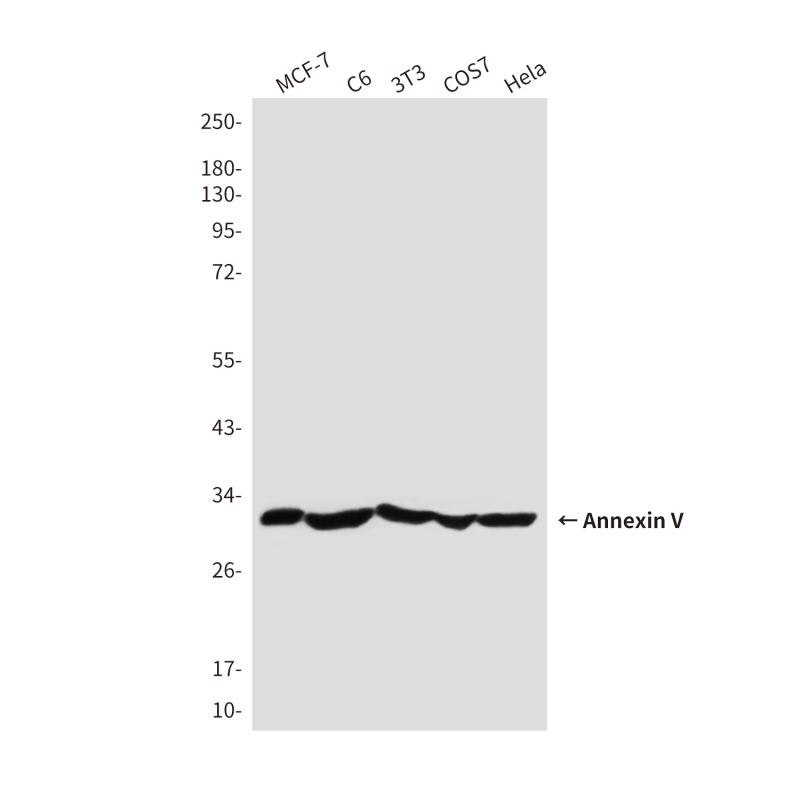
| WB | 咨询技术 | Human,Mouse,Rat |
| IF | 咨询技术 | Human,Mouse,Rat |
| IHC | 咨询技术 | Human,Mouse,Rat |
| ICC | 技术咨询 | Human,Mouse,Rat |
| FCM | 咨询技术 | Human,Mouse,Rat |
| Elisa | 咨询技术 | Human,Mouse,Rat |
| Aliases | PP4; ANX5; ENX2; RPRGL3. |
| Entrez GeneID | 308 |
| WB Predicted band size | Calculated MW: 36 kDa; Observed MW: 30 kDa |
| Host/Isotype | Rabbit IgG |
| Antibody Type | Primary antibody |
| Storage | Store at 4°C short term. Aliquot and store at -20°C long term. Avoid freeze/thaw cycles. |
| Species Reactivity | Human,Mouse,Rat,Monkey |
| Immunogen | Purified recombinant human Annexin V protein fragments expressed in E.coli. |
| Formulation | Purified antibody in PBS with 0.05% sodium azide,0.5%BSA and 50% glycerol. |
+ +
以下是3-4篇关于Annexin V抗体的代表性文献,按研究内容和应用方向简要概括:
---
1. **文献名称**:*Early exposure of phosphatidylserine in apoptotic cells detected by Annexin V-FITC staining*
**作者**:Koopman, G. et al.
**摘要**:该研究首次将Annexin V与荧光染料FITC偶联,用于流式细胞术检测早期凋亡细胞。通过结合碘化丙啶(PI)区分凋亡(Annexin V+/PI-)与坏死细胞(Annexin V+/PI+),建立了经典的凋亡检测方法。
2. **文献名称**:*Annexin V-affinity assay: A review on apoptosis detection in tissue sections*
**作者**:van Engeland, M. et al.
**摘要**:系统比较了Annexin V抗体在组织切片中检测凋亡的应用,探讨了其与TUNEL法的差异,强调Annexin V在早期凋亡检测中的特异性,但需注意钙离子依赖性结合可能导致的假阳性。
3. **文献名称**:*Binding of Annexin V to plasma membranes of human spermatozoa: A rapid assay for detection of membrane changes during cryopreservation*
**作者**:Glander, H.J. & Schaller, J.
**摘要**:利用Annexin V抗体开发了一种快速评估精子细胞膜完整性的方法,发现冷冻保存过程中磷脂酰丝氨酸(PS)的外翻与细胞膜损伤相关,为生殖医学提供了功能性检测工具。
4. **文献名称**:*Annexin V用于药物诱导肿瘤细胞凋亡的高通量筛选*
**作者**:Mittelman, A. et al.
**摘要**:研究将Annexin V抗体与微孔板检测技术结合,建立高通量筛选抗肿瘤药物的平台,通过量化PS暴露水平评估化疗药物诱导的凋亡效率,验证了其在药物开发中的应用潜力。
---
以上文献涵盖了Annexin V抗体在基础研究(凋亡机制)、临床诊断(组织病理)及工业应用(药物筛选)中的关键进展。如需具体DOI或发表年份,可进一步补充说明。
Annexin V antibodies are essential tools in apoptosis research, leveraging the natural binding properties of Annexin V, a calcium-dependent phospholipid-binding protein. Discovered in the 1980s, Annexin V specifically interacts with phosphatidylserine (PS), a phospholipid normally confined to the inner leaflet of the plasma membrane in healthy cells. During early apoptosis, PS becomes externalized, serving as a hallmark "eat-me" signal for phagocytic cells. This unique feature led to the development of Annexin V-based probes, including fluorescently labeled Annexin V or antibody-conjugated versions, to detect PS exposure on dying cells.
Annexin V antibodies are widely used in flow cytometry, microscopy, and other assays to distinguish apoptotic cells from live or necrotic populations, often combined with membrane-impermeant dyes like propidium iodide (PI) to assess membrane integrity. Their applications span cancer biology, immunology, drug discovery, and neuroscience, where quantifying apoptosis is critical for studying disease mechanisms or evaluating therapeutic efficacy.
While recombinant Annexin V proteins remain common, antibodies against Annexin V are particularly valuable in multiplex assays, Western blotting, or immunohistochemistry to validate endogenous Annexin V expression or study its non-apoptotic roles, such as membrane repair or inflammation. However, their utility depends on proper controls, as PS exposure can also occur in non-apoptotic contexts like platelet activation. Advances in imaging flow cytometry and single-cell analysis continue to expand the precision of Annexin V-based apoptosis detection.
×